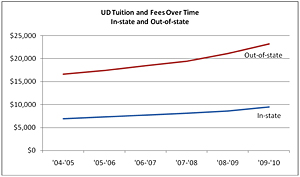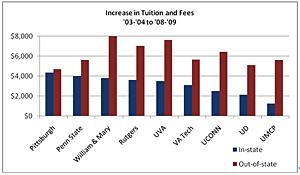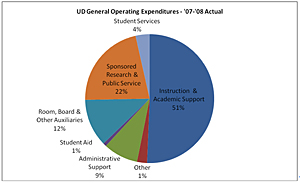

- Rozovsky wins prestigious NSF Early Career Award
- UD students meet alumni, experience 'closing bell' at NYSE
- Newark Police seek assistance in identifying suspects in robbery
- Rivlin says bipartisan budget action, stronger budget rules key to reversing debt
- Stink bugs shouldn't pose problem until late summer
- Gao to honor Placido Domingo in Washington performance
- Adopt-A-Highway project keeps Lewes road clean
- WVUD's Radiothon fundraiser runs April 1-10
- W.D. Snodgrass Symposium to honor Pulitzer winner
- New guide helps cancer patients manage symptoms
- UD in the News, March 25, 2011
- For the Record, March 25, 2011
- Public opinion expert discusses world views of U.S. in Global Agenda series
- Congressional delegation, dean laud Center for Community Research and Service program
- Center for Political Communication sets symposium on politics, entertainment
- Students work to raise funds, awareness of domestic violence
- Equestrian team wins regional championship in Western riding
- Markell, Harker stress importance of agriculture to Delaware's economy
- Carol A. Ammon MBA Case Competition winners announced
- Prof presents blood-clotting studies at Gordon Research Conference
- Sexual Assault Awareness Month events, programs announced
- Stay connected with Sea Grant, CEOE e-newsletter
- A message to UD regarding the tragedy in Japan
- More News >>
- March 31-May 14: REP stages Neil Simon's 'The Good Doctor'
- April 2: Newark plans annual 'wine and dine'
- April 5: Expert perspective on U.S. health care
- April 5: Comedian Ace Guillen to visit Scrounge
- April 6, May 4: School of Nursing sponsors research lecture series
- April 6-May 4: Confucius Institute presents Chinese Film Series on Wednesdays
- April 6: IPCC's Pachauri to discuss sustainable development in DENIN Dialogue Series
- April 7: 'WVUDstock' radiothon concert announced
- April 8: English Language Institute presents 'Arts in Translation'
- April 9: Green and Healthy Living Expo planned at The Bob
- April 9: Center for Political Communication to host Onion editor
- April 10: Alumni Easter Egg-stravaganza planned
- April 11: CDS session to focus on visual assistive technologies
- April 12: T.J. Stiles to speak at UDLA annual dinner
- April 15, 16: Annual UD push lawnmower tune-up scheduled
- April 15, 16: Master Players series presents iMusic 4, China Magpie
- April 15, 16: Delaware Symphony, UD chorus to perform Mahler work
- April 18: Former NFL Coach Bill Cowher featured in UD Speaks
- April 21-24: Sesame Street Live brings Elmo and friends to The Bob
- April 30: Save the date for Ag Day 2011 at UD
- April 30: Symposium to consider 'Frontiers at the Chemistry-Biology Interface'
- April 30-May 1: Relay for Life set at Delaware Field House
- May 4: Delaware Membrane Protein Symposium announced
- May 5: Northwestern University's Leon Keer to deliver Kerr lecture
- May 7: Women's volleyball team to host second annual Spring Fling
- Through May 3: SPPA announces speakers for 10th annual lecture series
- Through May 4: Global Agenda sees U.S. through others' eyes; World Bank president to speak
- Through May 4: 'Research on Race, Ethnicity, Culture' topic of series
- Through May 9: Black American Studies announces lecture series
- Through May 11: 'Challenges in Jewish Culture' lecture series announced
- Through May 11: Area Studies research featured in speaker series
- Through June 5: 'Andy Warhol: Behind the Camera' on view in Old College Gallery
- Through July 15: 'Bodyscapes' on view at Mechanical Hall Gallery
- More What's Happening >>
- UD calendar >>
- Middle States evaluation team on campus April 5
- Phipps named HR Liaison of the Quarter
- Senior wins iPad for participating in assessment study
- April 19: Procurement Services schedules information sessions
- UD Bookstore announces spring break hours
- HealthyU Wellness Program encourages employees to 'Step into Spring'
- April 8-29: Faculty roundtable series considers student engagement
- GRE is changing; learn more at April 15 info session
- April 30: UD Evening with Blue Rocks set for employees
- Morris Library to be open 24/7 during final exams
- More Campus FYI >>
11:42 a.m., July 8, 2009----Tuition for in-state undergraduate students at the University of Delaware will rise by $760 for the 2009-10 academic year, bringing the annual in-state tuition cost to $8,540. Undergraduate students from outside Delaware will pay $1,980 more in annual tuition. Their tuition next year will be $22,240.
Over the past five years, annual in-state tuition and fees at UD increased from $6,954 in 2004-05 to $9,486 in 2009-10, a total of $2,532. Out-of-state tuition and fees grew from $16,640 to $23,186 during the same period, an increase of $6,546.
Approximately 35 percent of next year's increase is necessary to cover costs of rapidly rising demand for financial aid among UD students. The economic downturn has led to many more students needing help under the University's Commitment to Delawareans and other financial aid programs. In the upcoming academic year 26 percent of tuition revenue is going directly to financial aid -- the highest in recent years. More than half of UD's students receive financial assistance, with an average need-based scholarship or grant of $6,025.
“We're experiencing increases in those students who will apply for and receive financial aid,” Provost Tom Apple said. Since Commitment to Delawareans was established in 2004, the initiative has grown to include an academic roadmap, a financial commitment to Delaware students and an early notification admission process for Delawareans. The total amount of financial aid from all funds for undergraduate students has grown by $34 million, from $55.7 million five years ago to $89.7 million this upcoming year, representing a 61 percent increase.
Tuition and fees account for approximately 31 percent of the full cost of educating a Delaware resident at the University of Delaware. The additional 69 percent is comprised of state appropriations, contracts and grants, endowment earnings and contributions.
Also contributing to UD's rising tuition and fees are the increasing costs of health insurance, property insurance and utilities, as well as a reduction in the amount of endowment proceeds available. UD's endowment value on May 31, $987 million, is down $357 million from a year prior, resulting in less annual endowment income available.
UD Executive Vice President Scott Douglass pointed out that UD has made significant cuts in spending amid the state's difficult fiscal situation. “Across the board administrative areas had already reduced their projected spending for next year, as well as future years, before we even considered an increase of tuition and fees,” he said.
UD tuition and fees have grown more slowly over time than those of its regional peer institutions. A comparison of UD undergraduate charges over the five year period between 2003-04 and 2008-09, the latest year comparable data is available, shows that all but one institution (University of Maryland-College Park) has increased in-state tuition and fees at a higher rate than UD. For out-of-state residents, all but one institution (University of Pittsburgh) has a higher rate of increase than UD.
“Undergraduate students at UD benefit from the breadth and depth of our academic offerings, superb faculty and opportunities to participate in knowledge-based research as well as service learning projects,” said Apple. “The investment in a UD education is a deposit on a path to transforming one's life and a students' future community for the better.”
UD receives an appropriation from the state to support the cost of education for in-state students and the academic, research and service mission of the University. This appropriation accounts for approximately 16 percent of the total UD budget. “We are subject to the same difficult economic realities as are all Delawareans; UD has experienced state operating budget reductions as well,” said Douglass.
While UD has a lower percentage of in-state resident students than other comparable state flagship universities, the number of Delaware students matriculating to UD this fall is 24 percent higher than last year. In total, nearly 40 percent of the University's students are Delawareans. Four out of five college-bound Delawareans apply to UD; 92 percent are admitted, either directly to the Newark campus (63 percent) or to the Associate in Arts program (29 percent), which can lead directly to a four-year degree from UD. By comparison, only 46 percent of out-of-state applicants are admitted.
More information on approved undergraduate tuition rates, room and board and student fees is available at the UD Billing and Collection Web site.
In order to achieve consistency in graduate student tuition rates across programs and colleges at the University, UD is implementing market-based tuition rates for all graduate students beginning with the fall semester in the 2009-10 academic year. For more information on the UD graduate tuition policy and answers to frequently asked questions, as well as approved rates for graduate student tuition and fees, visit the Graduate and Professional Education Web site.



